Kobe Steel Bundle
Who Really Controls Kobe Steel?
The ownership structure of a company is a critical determinant of its strategic direction, influence, and accountability. A pivotal moment, such as the acquisition of Kobayashi Seikosho in 1905 by Suzuki Shoten, marked the genesis of what would become Kobe Steel, Ltd.. Founded in 1911 in Wakinohamacho, Kobe, Japan, the company, initially named Kobe Seikosho, was established with a vision to contribute to the 'independence of Japanese industry' in the heavy industry sector.
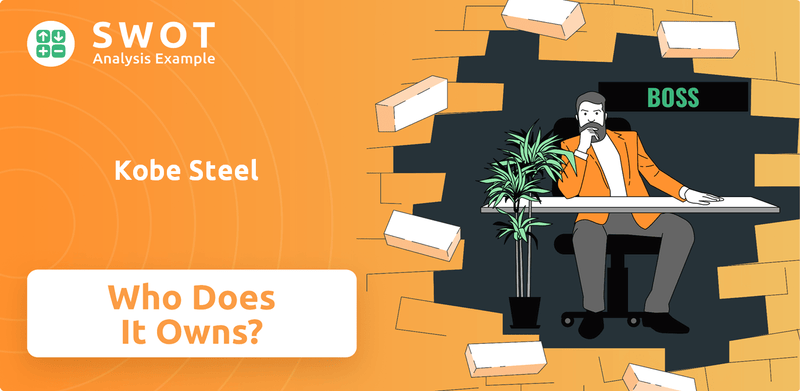
Kobe Steel, now known as Kobelco, has evolved into a global manufacturer of diverse materials including steel, aluminum, copper, and welding consumables, alongside businesses in industrial machinery, engineering, and real estate. As of March 31, 2025, Kobe Steel reported consolidated total assets of ¥2,891,053 million and a profit attributable to owners of parent of ¥120.1 billion for fiscal year 2024. To understand its position, consider a detailed Kobe Steel SWOT Analysis. The company is listed on the Tokyo and Nagoya Stock Exchanges and is a component of the Nikkei 225 index, indicating its significant market position. This exploration will delve into the intricate Kobe Steel ownership evolution, from its founding ownership and early backers to the current landscape of major institutional investors and public shareholders. Understanding these shifts provides crucial context for the company's governance and its trajectory within the global industrial landscape, offering insights into who owns Kobe Steel and the implications of its ownership structure.
Who Founded Kobe Steel?
The story of Kobe Steel begins in September 1905. That's when the general partnership trading company, Suzuki Shoten, acquired a steel business called Kobayashi Seikosho. This business was owned by Seiichiro Kobayashi in Wakinohama, Kobe. This acquisition marked the start of what would become a major player in the steel industry.
Shortly after the acquisition, the business was renamed to Kobe Seikosho. Later, in 1911, Suzuki Shoten took a significant step by spinning off this entity. This move formally established Kobe Steel Works, Ltd., solidifying its position as an independent company. While the exact initial shareholding percentages are not publicly available, Suzuki Shoten's role highlights its crucial early ownership and backing.
The early growth of Kobe Steel was significantly shaped by national policies. These policies were aimed at promoting private factories within the heavy industry sector. This strategic alignment provided a stable foundation for its initial operations and technological advancements. This strategic alignment provided a stable foundation for its initial operations and technological advancements.
Founded in September 1905, when Suzuki Shoten acquired Kobayashi Seikosho, a steel business owned by Seiichiro Kobayashi.
The acquired business was renamed to Kobe Seikosho, setting the stage for the company's future identity.
In 1911, Suzuki Shoten spun off the entity to formally establish Kobe Steel Works, Ltd., marking its independent status.
National policies fostering private factories in heavy industry played a key role in the company's early development.
Received technical guidance and orders from imperial Japanese naval arsenals, which were instrumental in its expansion.
Early development was structured and strategic, benefiting from Suzuki Shoten's backing and governmental support.
The early years of Kobe Steel were marked by a close relationship with the Japanese government. Following the Russo-Japanese War, the company received technical guidance and orders from naval arsenals. This support was crucial for its growth and technological advancements. This symbiotic relationship, rather than relying on angel investors, defined its early success. For more insights, you can explore the Growth Strategy of Kobe Steel.
Kobe Steel SWOT Analysis
- Complete SWOT Breakdown
- Fully Customizable
- Editable in Excel & Word
- Professional Formatting
- Investor-Ready Format
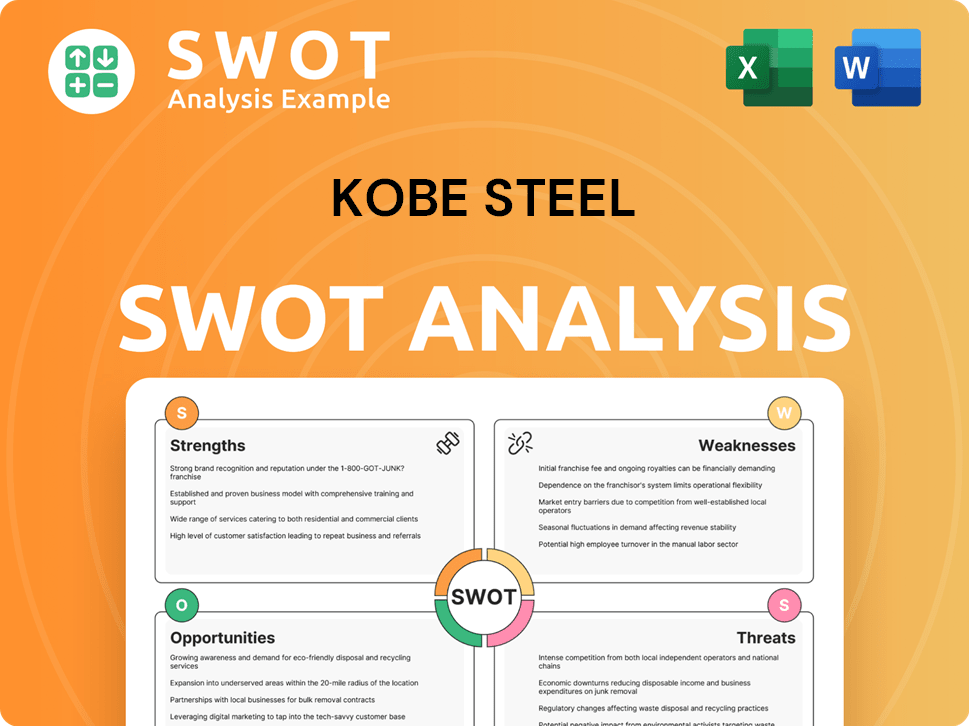
How Has Kobe Steel’s Ownership Changed Over Time?
Understanding the ownership of the Kobe Steel company involves examining its publicly traded status and the composition of its shareholders. The company, trading on the Tokyo Stock Exchange under the ticker symbol 5406, had its initial public offering on January 4, 2000. As of June 2025, the market capitalization of Kobe Steel is approximately $4.43 billion USD, reflecting its significant presence in the global market. This financial standing is a key indicator for investors and stakeholders interested in the company's performance and future prospects. The evolution of Kobe Steel's ownership structure is a dynamic process, shaped by various factors.
The ownership structure of Kobe Steel is diverse, encompassing institutional investors, corporate entities, and employee shareholding programs. As of March 31, 2025, key shareholders include The Master Trust Bank of Japan, Ltd. (Trust Account) with 16.94% of voting rights, and Custody Bank of Japan, Ltd. (Trust Account) with 4.26%. Other significant investors include The Nomura Trust and Banking Co., Ltd. (Trust Account) with 2.22%, and STATE STREET BANK AND TRUST COMPANY, holding varying percentages across different accounts. Nippon Life Insurance Company holds 1.28%, and the Kobe Steel Employee Stock Ownership Plan holds 1.09%. These details provide a clear picture of who owns Kobe Steel and the distribution of its shares.
| Shareholder | Percentage of Voting Rights (as of March 31, 2025) | Notes |
|---|---|---|
| The Master Trust Bank of Japan, Ltd. (Trust Account) | 16.94% | Significant institutional investor |
| Custody Bank of Japan, Ltd. (Trust Account) | 4.26% | Institutional investor |
| The Nomura Trust and Banking Co., Ltd. (Trust Account) | 2.22% | Institutional investor |
| STATE STREET BANK AND TRUST COMPANY | Varies (e.g., 1.41% for account 505001, 1.02% for account 505103) | Institutional investor |
| Nippon Life Insurance Company | 1.28% | Institutional investor |
| Kobe Steel Employee Stock Ownership Plan | 1.09% | Employee shareholding |
Kobe Steel's strategic direction is also influenced by its membership in the Mizuho keiretsu, a Japanese business grouping. This affiliation affects its relationships and strategic alliances. Furthermore, Kobe Steel's recent actions, such as selling its shares in Nippon Steel to enhance capital efficiency, and the agreement to make Nippon Koshuha Steel Co., Ltd. a wholly-owned subsidiary, demonstrate its commitment to strategic restructuring and maximizing shareholder value. For more context on the competitive landscape, you can explore the Competitors Landscape of Kobe Steel.
Kobe Steel's ownership is a mix of institutional investors and employee shareholding. Key shareholders include The Master Trust Bank of Japan and Custody Bank of Japan. Recent strategic moves include share sales and acquisitions to enhance efficiency and shareholder value.
- Publicly traded company on the Tokyo Stock Exchange.
- Significant institutional investor presence.
- Strategic restructuring through share transactions.
- Member of the Mizuho keiretsu.
Kobe Steel PESTLE Analysis
- Covers All 6 PESTLE Categories
- No Research Needed – Save Hours of Work
- Built by Experts, Trusted by Consultants
- Instant Download, Ready to Use
- 100% Editable, Fully Customizable
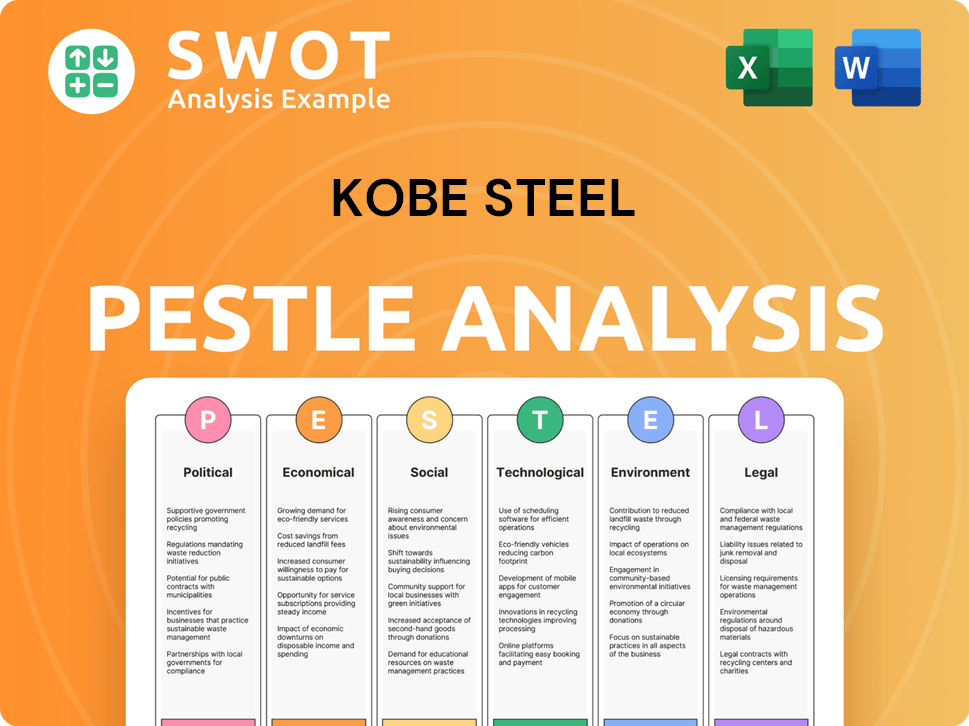
Who Sits on Kobe Steel’s Board?
As of April 2024, Yoshihiko Katsukawa serves as the President, CEO, and Representative Director of Kobe Steel, Ltd. His direct ownership is noted as 0.011% of the company's shares as of June 2025, valued at approximately €428.29K. The board of directors has an average tenure of 3 years, while the management team has an average tenure of 5.3 years. This indicates a blend of experienced leadership and a stable management structure within the company. The Marketing Strategy of Kobe Steel is influenced by its ownership and leadership dynamics.
For its affiliate Shinsho Corporation, the board of directors as of June 26, 2024, includes Hironobu Takashita as President and CEO, Masahito Adachi and Satoshi Nishimura as Representative Directors and Senior Executive Officers. Satoshi Nishimura previously held executive officer roles at Kobe Steel, Ltd., indicating connections between the parent company and its affiliates. For Kobelco Logistics, Ltd., a group company, Yoshihumi Yamanaka, Satoshi Kazahaya, and Nobuo Sakaymama are listed as Outside Directors (Independent Executive), suggesting a commitment to independent oversight within the broader Kobe Steel Group. These details offer insights into the Kobe Steel company ownership structure and its subsidiaries.
| Board Member | Title | Ownership (June 2025) |
|---|---|---|
| Yoshihiko Katsukawa | President, CEO, Representative Director | 0.011% |
| Hironobu Takashita | President and CEO (Shinsho Corporation) | N/A |
| Masahito Adachi | Representative Director and Senior Executive Officer (Shinsho Corporation) | N/A |
Kobe Steel's voting structure generally follows a one-share-one-vote principle, common in Japan. There are no special voting rights. The company announced a share repurchase program in June 2025 to buy back up to 1,900,000 shares, representing 0.48% of its issued share capital, for ¥3,900 million. This is part of its strategic acquisitions and capital structure optimization, reflecting how Kobe Steel ownership is managed.
The CEO's direct ownership is minimal, indicating leadership control. Institutional shareholders significantly influence the company. The board includes members from affiliated companies, showing interconnected governance.
- One-share-one-vote voting structure.
- Share repurchase program for strategic purposes.
- Focus on independent oversight within group companies.
- Strategic consolidation of subsidiaries.
Kobe Steel Business Model Canvas
- Complete 9-Block Business Model Canvas
- Effortlessly Communicate Your Business Strategy
- Investor-Ready BMC Format
- 100% Editable and Customizable
- Clear and Structured Layout
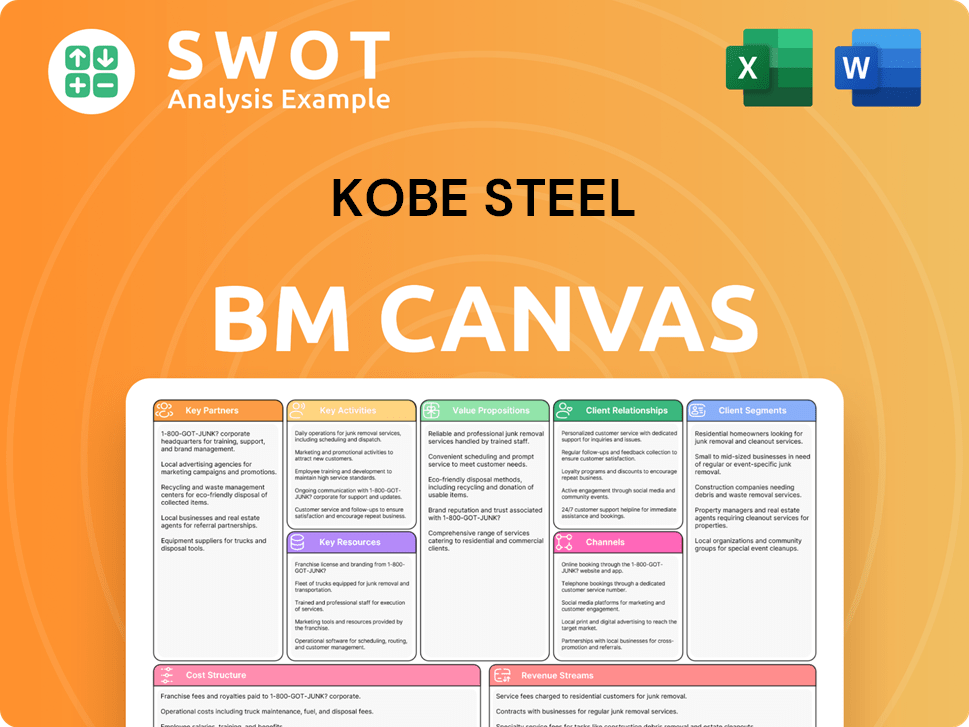
What Recent Changes Have Shaped Kobe Steel’s Ownership Landscape?
Over the past few years, significant shifts have reshaped the Kobe Steel ownership landscape. A major move in 2025 involves the full acquisition of Nippon Koshuha Steel Co., Ltd., a subsidiary, through a share exchange, making it a wholly-owned entity by February 2, 2026. This strategic restructuring aims to streamline business segments and potentially boost corporate value. These changes reflect ongoing efforts to optimize the company's structure.
Kobe Steel has also been active in share buybacks to manage its capital structure. In June 2025, the company completed a repurchase of 1,900,000 common shares, totaling approximately ¥3.11 billion. Furthermore, the company is unwinding cross-shareholdings, selling its entire stake in Nippon Steel to improve capital efficiency, aligning with its Medium-Term Management Plan for fiscal years 2024-2026. This is part of a broader trend in Japan to enhance corporate governance.
| Development | Details | Impact |
|---|---|---|
| Acquisition of Nippon Koshuha Steel | Share exchange to make it a wholly-owned entity by February 2, 2026, followed by transfer of special steel business to Daido Steel Co., Ltd. | Streamlines business segments, potentially enhances corporate value. |
| Share Buybacks | Completed repurchase of 1,900,000 common shares in June 2025, totaling ¥3.11 billion. | Optimizes capital structure. |
| Unwinding Cross-Shareholdings | Selling entire stake in Nippon Steel (6,744,000 shares). | Improves capital efficiency, aligns with Medium-Term Management Plan. |
Financially, Kobe Steel demonstrated robust performance, reporting a record-high profit attributable to owners of parent of ¥120.1 billion for fiscal year 2024, with a forecast of ¥100.0 billion for fiscal year 2025. The company announced an annual dividend of ¥100 for fiscal 2024 and a forecast of ¥80 for fiscal 2025. Additionally, the company is adjusting its investment plans for decarbonization between 2024 and 2026, reducing its allocation from ¥300 billion to approximately ¥150 billion. This shift may affect long-term ownership by ESG-focused investors. For more details on the target market, you can read the article Target Market of Kobe Steel.
Record-high profit of ¥120.1 billion for fiscal year 2024; forecast of ¥100.0 billion for fiscal year 2025.
Annual dividend of ¥100 for fiscal 2024; forecast of ¥80 for fiscal 2025.
Investment adjusted from ¥300 billion to approximately ¥150 billion between 2024 and 2026.
Repurchased 1,900,000 common shares, totaling approximately ¥3.11 billion in June 2025.
Kobe Steel Porter's Five Forces Analysis
- Covers All 5 Competitive Forces in Detail
- Structured for Consultants, Students, and Founders
- 100% Editable in Microsoft Word & Excel
- Instant Digital Download – Use Immediately
- Compatible with Mac & PC – Fully Unlocked
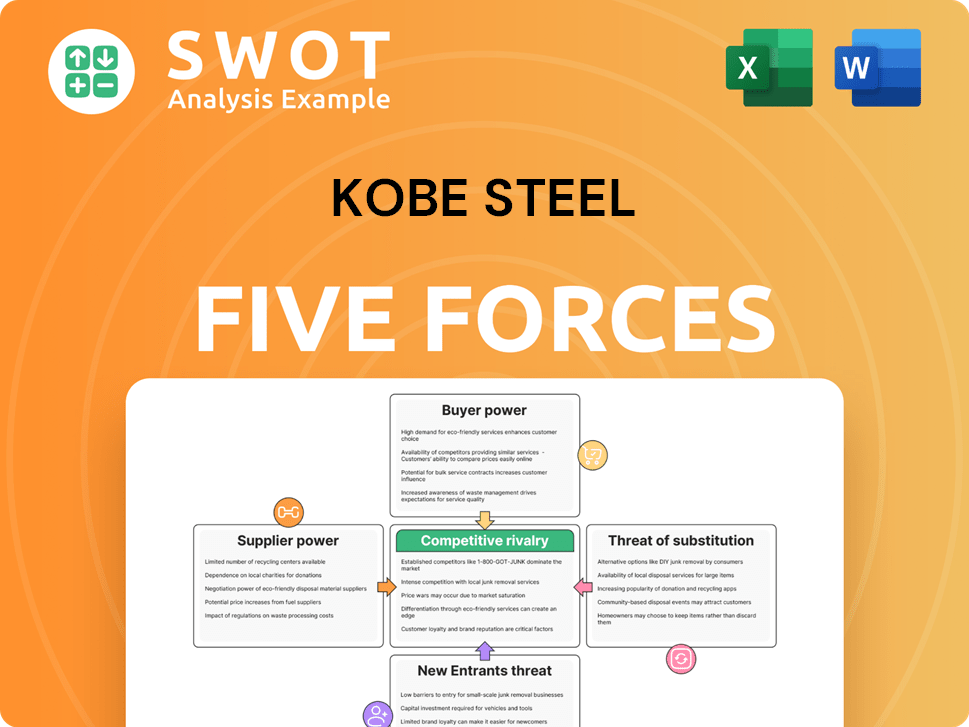
Related Blogs
- What are Mission Vision & Core Values of Kobe Steel Company?
- What is Competitive Landscape of Kobe Steel Company?
- What is Growth Strategy and Future Prospects of Kobe Steel Company?
- How Does Kobe Steel Company Work?
- What is Sales and Marketing Strategy of Kobe Steel Company?
- What is Brief History of Kobe Steel Company?
- What is Customer Demographics and Target Market of Kobe Steel Company?
Disclaimer
All information, articles, and product details provided on this website are for general informational and educational purposes only. We do not claim any ownership over, nor do we intend to infringe upon, any trademarks, copyrights, logos, brand names, or other intellectual property mentioned or depicted on this site. Such intellectual property remains the property of its respective owners, and any references here are made solely for identification or informational purposes, without implying any affiliation, endorsement, or partnership.
We make no representations or warranties, express or implied, regarding the accuracy, completeness, or suitability of any content or products presented. Nothing on this website should be construed as legal, tax, investment, financial, medical, or other professional advice. In addition, no part of this site—including articles or product references—constitutes a solicitation, recommendation, endorsement, advertisement, or offer to buy or sell any securities, franchises, or other financial instruments, particularly in jurisdictions where such activity would be unlawful.
All content is of a general nature and may not address the specific circumstances of any individual or entity. It is not a substitute for professional advice or services. Any actions you take based on the information provided here are strictly at your own risk. You accept full responsibility for any decisions or outcomes arising from your use of this website and agree to release us from any liability in connection with your use of, or reliance upon, the content or products found herein.